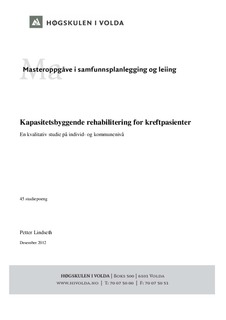| dc.description.abstract | Abstract
This is a qualitative study, subject being cancer and municipal planning. The goal is: How do in-patient rehabilitation programs for cancer survivors lead to capacity building for the attending participants afterwards, and what are the implications for local monitoring and planning? To illustrate the issue, the following methods were used: interviews of nine informants on an individual level and two group interviews on a municipal level. A semi-structured interview guide has been used for each interview. Analytical framework is inspired by Patsy Healy’s model of institutional capacity building, focusing on the development of knowledge resources, relational resources and mobilization capability. Healey argues that by stimulating these resources it affects mobilization capability, and institutional capacity-building can occur. Results: Several informants describes the stay as a safe "restart" after cancer treatment, but that there is a need for individual support and assistance in the home environment. Fatigue affects mobilization capability greatly. Knowledge resources: Participants have become more physically active afterwards, but need reminding and maintenance of the knowledge they achieved during their stay. The situation of their next-of-kin is underestimated, both in the family and with the cancer support services. There is a lack of understanding and knowledge of what people with cancer need when it comes to support services. Consultancy on social issues is general and not tailored to individual needs. Relationship Resources: Nav is a vulnerable relation resource. There is often a vacuum after treatment although the services in the municipalities is considered good but fragmented. At the municipal level, there is no established systematic follow-up of cancer patients and their next-of-kin beyond the palliative phase. There is no systematic learning in the area of cancer, and user experience is not included. But the municipalities have knowledge- and relation resources which involves potential for capacity building. Conclusion: The experience of cancer survivors in this paper are varied and full of contrasts, and the degree of capacity building for the participant after a rehabilitation stay is dependent on an individual approach and monitoring in the home environment and community. This implies that municipalities must build capacity beyond palliative care in patient care. Capacity-building planning in an interactive patient care is proposed as the basis for institutional capacity- building.
Key words: capacity building and cancer, cancer care coordination, cancer survivorship, rehabilitation after cancer, cancer planning | no_NO |
